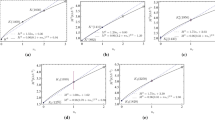Abstract
The mass spectra of charmonia and bottomonia are calculated in the framework of the relativistic quark model up to high orbital and radial excitations. The Regge trajectories of heavy quarkonia are constructed both in the (J,M 2) and (n r ,M 2) planes, where J is the total angular momentum and nr is the radial quantum number. All daughter trajectories turn out to be almost linear and parallel, while parent trajectories exhibit some nonlinearity. Such nonlinearity occurs only in the vicinity of ground states and few lowest excitations and is more pronounced for bottomonia, while it is only marginal for charmonia. The obtained results are compared with available experimental data, and a possible interpretation of the new charmonium-like states above open charm production threshold is discussed.
Similar content being viewed by others
References
K. Nakamura et al. (Particle Data Group), J. Phys. G 37, 075021 (2010) (and 2011 partial update for the 2012 edition).
N. Brambilla et al., Eur. Phys. J. C 71, 1534 (2011).
E. Klempt and A. Zaitsev, Phys. Rept. 454, 1 (2007).
L. L. Gioi, arXiv:1109.3398 [hep-ex].
D. Ebert, R. N. Faustov, and V. O. Galkin, Phys. Rev. D 79, 114029 (2009).
S. Gupta and S. F. Radford, Phys. Rev. D 24, 2309 (1981); 25, 3430 (1982); J. Pantaleone, S.-H.H. Tye, and Y. J. Ng, Phys.Rev. D 33, 777 (1986).
S. S. Gershtein, A. K. Likhoded, and A. V. Luchinsky, Phys. Rev. D 74, 016002 (2006).
A. M. Badalian, Phys. Atom. Nucl. 74, 1375 (2011) [Yad. Fiz. 74, 1401 (2011)].
D. Ebert, R. N. Faustov, and V. O. Galkin, Phys. Rev. D 67, 014027 (2003).
D. Ebert, R. N. Faustov, and V. O. Galkin, Eur. Phys. J. C 66, 197 (2010).
I. Adachi et al. (Belle Collab.), arXiv:1110.3934 [hepex].
J. P. Lees et al. (The BABAR Collab.), Phys. Rev. D 84, 091101(R) (2011); I. Adachi et al. (Belle Collab.), Phys. Rev. Lett. 108, 032001 (2012).
D. Ebert, R. N. Faustov, and V. O. Galkin, Phys. Lett. B 634, 214 (2006); Eur. Phys. J. C 58, 399 (2008); Mod. Phys. Lett. A 24, 567 (2009).
T. Aaltonen et al. (CDF Collab.), Phys. Rev. Lett. 102, 242002 (2009).
S.-K. Choi et al. (Belle Collab.), Phys. Rev. Lett. 100, 142001 (2008); R. Mizuk et al. (Belle Collab.), Phys. Rev. D 78, 072004 (2008); 80, 031104(R) (2009).
Author information
Authors and Affiliations
Additional information
The text was submitted by the authors in English.
Rights and permissions
About this article
Cite this article
Ebert, D., Faustov, R.N. & Galkin, V.O. Spectroscopy and Regge trajectories of heavy quarkonia in the relativistic quark model. Phys. Atom. Nuclei 76, 1554–1562 (2013). https://doi.org/10.1134/S1063778813110057
Received:
Published:
Issue Date:
DOI: https://doi.org/10.1134/S1063778813110057




